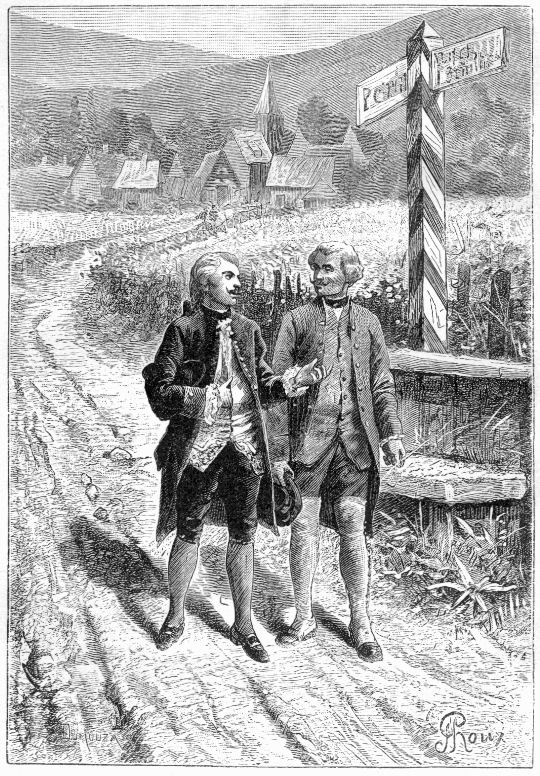Topicality and history was an essential element in Jules Verne’s series, the “Voyages Extraordinaires” (“Extraordinary Journeys”), and many episodes of his era were included. Six books reflected the 19th century fascination with African exploration [1] and reaching the polar regions. [2] Similarly, the Yukon gold rush that occurred late in Verne’s life would be portrayed (Le Volcan d’or [The Golden Volcano, 1906]). Modern transportation, such as railroads and steamers, were found in many stories, most prominently in the chronicle of the trans-Atlantic vessel the Great Eastern (Une Ville flottante [A Floating City, 1871]). The American Civil War became a subject, first as a contemporary event, then as history. [3] Similarly, other historical events were featured, including the Greek War of Independence, [4] the Quebec revolt for independence, [5] and the Sepoy revolt in India. [6]
However, one event which must have been very close to any Frenchman’s heart seems to have been treated in a very remote fashion. The French Revolution was only examined externally in Le Chemin de France (The Road to France, 1887), depicting the attack of the coalition of Austria and Prussia against the Republic. The Revolution itself, as it occurred in France, was not part of the “Extraordinary Journeys.”
Or was it?
In fact, it was meant to be included. Only decisions by Verne’s primary publisher, Pierre-Jules Hetzel, and Verne’s son, Michel, resulted in this absence. Verne did write a novel of the Revolution as a civil conflict, within France, vividly portraying the overthrow of the king and counter-revolutions. And he selected a particularly vicious portion of the conflict, the suppression of a revolt near his birthplace of Nantes. Le Comte de Chanteleine : Un Episode de la Révolution (The Count of Chanteleine: A Tale of the Revolution) was serialized in three issues of the magazine Musée des Familles (Family Museum) in 1864, shortly after Hetzel’s breakthrough publication of Five Weeks in a Balloon that won Verne best-seller status. Verne’s contract with Hetzel allowed the author to publish one text per year in Musée des Familles, since it had no affiliation with Hetzel; another historically-themed novelette, The Blockade Runners, was published in Musée des Familles in 1865. By then, however, Verne’s emphasis on a new genre was becoming clear as he continued his work for Hetzel with Voyage au centre de la terre (Journey to the Center of the Earth, 1864) and De la Terre à la lune (From the Earth to the Moon, 1865).
Understandably, most study of Verne has dwelled on science fiction, the literary genre he did so much to develop. Nonetheless, more than half of his novels belong to different genres, primarily adventure, along with comedy and mystery. The adventure genre formed the foundation of the "Extraordinary Journeys," and was the most often invoked formula, a staple that allowed Verne to keep up his astonishing output of one or two novels annually. During the 19th century, adventure was an emerging generic tradition, popular and saleable, and the classical forms of Sir Walter Scott and Alexander Dumas, père, were adopted by Verne. This was evident in his 1850s short stories “Un drame au Mexique—Les premiers navires de la marine mexicaine” (“A Drama in Mexico—The First Ships of the Mexican Navy”), Martin Paz, A Winter Amid the Ice, "San Carlos," and Le Siège de Rome (The Siege of Rome). Verne’s success with the genre would become notable, especially with Le Tour du monde en quatre-vingts jours (Around the World in Eighty Days) and Michel Strogoff (Michael Strogoff), equally popular as 1870s books and when he adapted them shortly after for the stage.
The Count of Chanteleine uses a form indebted to Verne’s friend and idol Dumas, especially his stories of the Musketeers and Monte Cristo. The swashbuckler is an adventure type using European (or Europeanized) history as the background for heroes and villains who are largely fictional but whose conflict incarnates larger issues of government and justice. The swashbuckler adventure usually opens with oppression imposed on a peaceful land, resulting in a rebellion that calls forth a leader dedicated to the rights of the people. The swashbuckler dwells on individuals, elevating their importance amidst the background of history. With the hero's aid, either a just regime is restored or a new, improved establishment is created, replacing one that had proved liable to transgression by tyrants.
While the prototype of the swashbuckler is the myth of Robin Hood, the figure has been elaborated historically through more recent manifestations in popular literature from the Scarlet Pimpernel to Zorro. The tenets of the genre, offering portrayals of heroes and heroines of nobility, self-sacrifice, vigor, and virtue, may be fulfilled from a variety of directions, so long as the struggle for freedom is upheld against various forms of oppression around the globe, celebrating the rise of individual freedom and self-determination. Whether the hero is a peasant rebelling against unjust rule, or a noble opposing a usurper, the motive always remains the same, to defend the broad interests of the people.
The swashbuckler offers the appeal of characters who briefly yet honorably transgress the law, yet whose ultimate impact is to uphold morality. Outlaw deeds are ultimately sanctioned, since the actual lawbreakers are those who have attempted to seize political power, often employing drastic means. Swashbucklers stress the purity of the hero's motives, never seeking personal gain, dedicated to a righteous cause and demonstrating physical and mental agility. The aristocracy in the swashbuckler is one of bearing rather than inheritance, and may encompass noble or commoner, aristocrat or peasant.
The Count of Chanteleine begins by setting the historical backdrop. An indirect result of ending special privileges for local nobility was that the state now imposed a degree of control over regions beyond what the monarchy had exerted, creating a series of administrative departments, with a determination to extinguish provincial separatism. (Piette, 88; Goodwin, 352) A Catholic and Royalist “White” army assembled in March 1793, a socially-inclusive resistance that brought together all ranks, classes, and ages, men and women alike, from the entire region. (Schama, 696) Soon the Whites of the western provinces were victorious against the Blues of the Revolution. Reprisals came quickly. In the Vendée, as Verne notes in The Count of Chanteleine, the government “embarked on a campaign of the most horrible devastation … pillaging, massacring, and destroying. No one, women, children, or old men, escaped their bloody reprisals.” [7] (Chapter 12) By December 23, the Catholic Royalist resistance was routed, beginning a long retreat, depicted by Verne in vivid language. “Newborn children were exposed naked to all the rigors of the elements; their mothers had nothing to cover them with. Hunger and cold added their torments to all the suffering. Cattle fleeing along the same route bellowed above the sound of the storm ….” (Chapter 2) Over 20,000 were involved in this long retreat, punctuated with sporadic losing battles. (Schama, 787)
Verne depicts the lack of honor on the part of the Blues, regarding their opponents as brigands worthy only of extermination, even after surrendering. The Reign of Terror dehumanized adversaries as a matter of ideology, executing thousands, with some of the most notorious massacres in Nantes. (Schama, 788-789) The policy of “pacification” included routine rape and mutilation of women and children, as well as the slaughter of combatants, sometimes killed so they would fall into their own mass graves. The loss in life was at least 40,000 and quite possibly a quarter of a million or more, one third of the region’s population, creating what many regard as the first modern genocide. Chapter 2 of The Count of Chanteleine was constructed around the results of the policies of Jean-Baptiste Carrier in Nantes, who shot hundreds of priests and executed or starved to death thousands of royalists, many of them rebellious peasants. Even Robespierre believed Carrier had gone to excess and recalled him to Paris. (Piette, 96)
The titular character of The Count of Chanteleine is first introduced amidst the combat, “a tall, handsome man of about forty-five. His face was bold and noble, but sad because of the powder and blood that covered it. He looked magnificent, despite his bespattered clothes. In one hand he held the pistol he had just fired and in the other his bloody and battered sword.” (Chapter 1) Here Verne offers a fearless adventure hero, a man who incarnates the expected virtues of aristocracy; the fact that during the entire novel Humbert de Chanteleine is almost always referred to by his title, rather than name, indicates how his characterization was intended to embody nobility of nature emerging against a tumultuous backdrop. He is a symbol as much as he is a three-dimensional character, no less than Jean Sans-Nom stands for the rebellion against English dominion in Family Without a Name—as Jean Chouan gave his name to the Vendée counter-revolutionaries, the chouans.
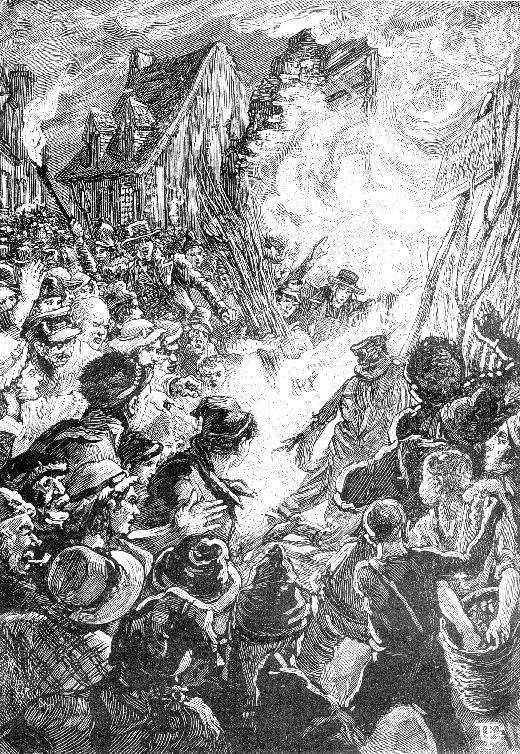
Revolutionary violence in Famille-sans-nom (Family Without a Name, 1889)
Chanteleine is descended from one of the oldest lines in Brittany, whose lands have belonged to them since time immemorial, and who has always been semi-autonomous in his relation to the crown. (In this way, Chanteleine stands apart from any royal tyranny.) In fact, there had long been an unusually close relationship in Brittany between peasantry and feudal superiors. (Goodwin, 334) After the Revolution, many Breton nobles, isolated and under pressure, had renounced their seigneurial rights, accepting the new order. (Piette, 87)
The swashbuckler formula that Verne used, of a nobly-born hero with the characteristics desired for one of his background and education, was misread by Hetzel as implying a political agenda. Yet evidently Hetzel failed to notice the same formula evident elsewhere in many other “Extraordinary Journeys.” Michael Strogoff’s trek served to uphold the rule of the Czars, situated opposite barbaric foreign invaders. Yet the novel is not an attempt to analyze and support the Russian social order, but is a tribute to heroism—allowing not only the Czar and Grand Duke, as well as Michael, together with a pardoned rebel and his daughter, to overcome danger to the motherland. Dakkar is a prince leading his people in the Sepoy revolt before becoming Captain Nemo of the Nautilus. James Burbank is a civic leader among the lesser white gentry of Florida in North Against South. Like Strogoff, Dakkar, and Burbank, the Count of Chanteleine stands out among many of those around him, and no less than Dakkar in India, the count was to be found in the midst of the resistance for ten months, “always in the front ranks, [taking] part in all the victories and all the defeats.”
However, rather than the titular figure, the primary character in The Count of Chanteleine is his peasant-born friend and right arm, Kernan, through whom most of the narrative is told. No less than the count, Kernan is presented as a bold adventurer.
The peasant was wearing a brown woolen cap with a broad brimmed hat on top, surrounded by a rosary. The hat cast a shadow over his energetic and rugged face.… On his feet he wore a pair of enormous, badly damaged clogs … A goat-skin flung over his back completed the Breton’s attire. The hilt of a cutlass protruded from his belt with its large buckle, and his right hand gripped the barrel of a musket.
This peasant must have been extremely powerful. Indeed, he had a reputation in his region for incredible, even superhuman, strength. Stories were told of his astonishing deeds, and the terrible wrestler had never met his match at any of the festivals in Brittany. (Chapter 2)
Kernan is a man of no exceptional birth, but serves the count and his family and is rewarded with complete trust, to the extent that the count’s daughter refers to Kernan as her uncle, and he refers to her as his niece. There is no social differentiation here; Verne vitally portrays the mixing of class backgrounds. Since childhood, the count and Kernan have never been separated, giving him an unusual education for his class. The count would have preferred leaving his family and castle in Kernan’s hands during his absence, but it was impossible for the two not to fight alongside one another like brothers. Kernan is the hope for France’s future, a melding of the best of peasant background and noble education, just as the count represented the country’s best traditions.
The hero’s personal enemies in the swashbuckler are often the same as those who menace society at large. The contrast with those who have misdirected the Revolution is reflected in Kernan’s mirror image, Karval, the antagonist of The Count of Chanteleine. Like Kernan, Karval had also been a servant of the count, but after two years he was discovered to have stolen from the household. Chanteleine regarded dismissal as adequate punishment, far more lenient than the peasants would have inflicted on Karval, as one who had disgraced their class. Just as the count displayed Christian forgiveness and ultimately becomes a man of God, Karval, expelled from the heavenly existence on the Chanteleine lands, becomes a veritable devil. He flees to Paris, which the Breton peasants regarded as an antechamber of hell, since the only one who had gone there returns a criminal.
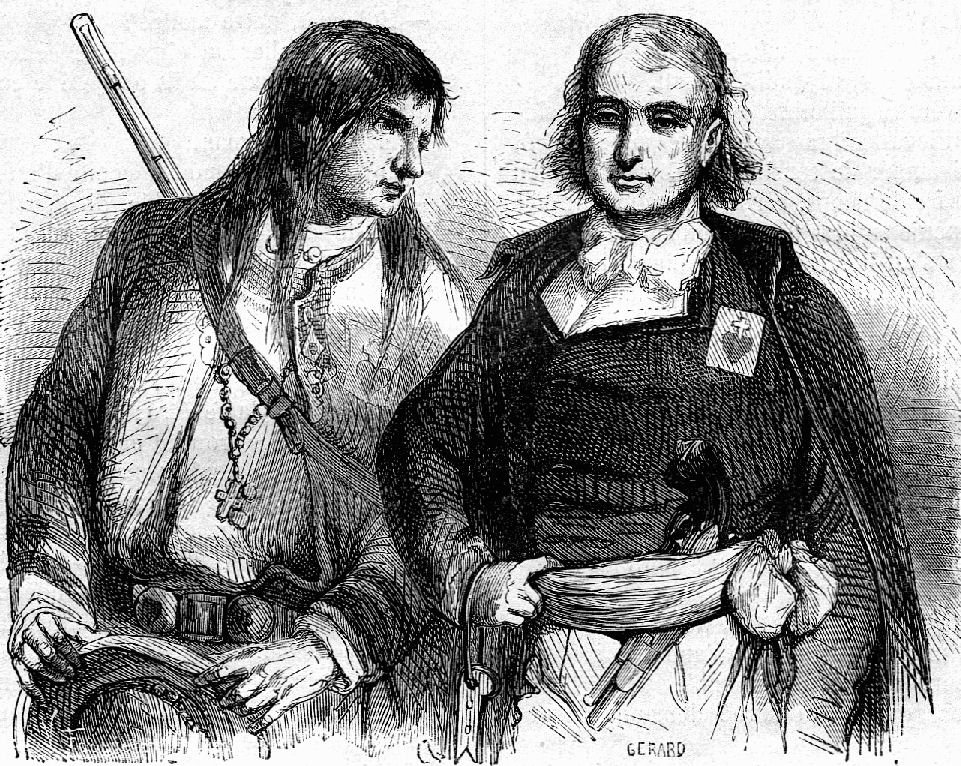
Kernan and Chanteleine
While both Kernan and Chanteleine are noble by thought and action, Karval is craven by nature.
Karval was a man of medium height, with the kind of face that is produced over time by hatred, pettiness, and meanness. Every new vice sank in and left its mark. He was not lacking in intelligence, but one had the impression, on seeing him, that he must be a coward. Like many heroes of the Revolution, he was blood-thirsty out of fear, but out of fear also he was inflexible and without human feeling. (Chapter 5) He is an opportunist, fueling the savagery of the Terror in his own desire to be among its leaders. At one point, accompanied by “his bloody mob,” Karval is “hideous, blood-stained, nearly drunk, driving before him the elderly, the wounded, women, children, and unfortunate Vendéan prisoners, plucked out of the routed grand army and now on their way to the scaffold.” (Chapter 6)
Verne is at pains to portray Chanteleine as a wise, beneficent figure in his district, the opposite of the exploitative aristocrat whom Verne mentions in other passages. The Chanteleines are so beloved by their peasants, it is noted, that they could have given lessons to the kings of France. For twenty years, Madame Chanteleine “devoted herself entirely to the happiness of those who came to her. Since she knew that by doing good she made her husband happy, she was continually seen at the bedside of the ill, taking in old folk, providing instruction for children, and founding schools.” Her 17-year-old daughter Marie had followed her in these good deeds. (Chapter 4)
Despite the wish of the count’s wife and daughter to fight alongside him, as other women of a similar station had done, the count insisted they remain at home, seemingly safe. However, once the retreat has begun, the Count must leave the fighting to save his family, who reassume primary importance in his life. This narrative device is also essential for Chanteleine and Kernan to experience the atrocities that have happened away from the front lines. Arriving home, he learns that his wife was killed by the Republicans after they seized his castle, and Marie taken prisoner; as in Paris au XXe siècle (Paris in the 20th Century), written about the same time, there is a vivid scene in a cemetery, as the count grieves for his wife and believes his daughter has also perished.
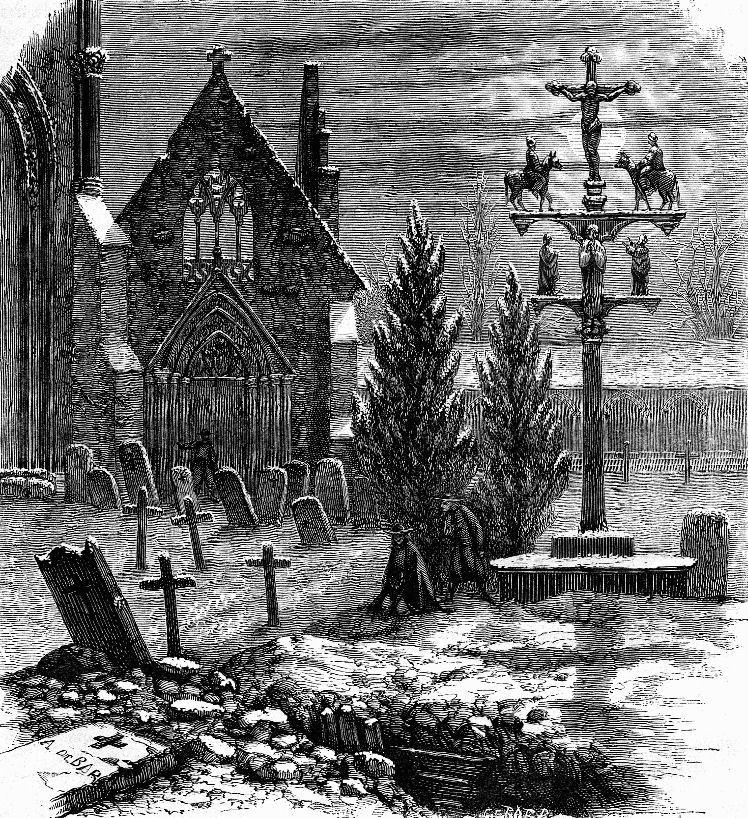
Chanteleine grieves
In depicting the excesses of the French Revolution by centering on persecuted innocents, The Count of Chanteleine resembles the recent novel A Tale of Two Cities, published in 1859, and translated in France in 1861. Author Charles Dickens was a lifelong favorite of Verne, to the extent that in discussing a much later Verne novel, P’tit-Bonhomme (Little Boy, 1893), an Irish social drama, he would publicly acknowledge his debt to the Englishman.
However, The Count of Chanteleine suggests that Little Boy was not the first case of Verne’s Dickensian inspiration. Marie is saved through a substitution and sacrifice, evocative of the climax in A Tale of Two Cities, when Sydney Carton gives his life so that Charles Darnay may live and marry the woman both love, Lucie Manette. The Chevalier Henry de Trégolan holds a pardon for his sister, but is only minutes too late to save her from the guillotine. “’My poor sister’s head,’ went on the chevalier, sobbing, ‘had just rolled onto the scaffold as I watched.’” (Chapter 7) Still dazed, he realizes he has the means to save the life of another young woman, and Marie, facing death herself, is the lucky beneficiary.

The frontispiece for Verne's 1893 Dickensian novel of British children
Following this ordeal is a more peaceful interlude in Douarnenez, a fishing village, seeking refuge with Locmaillé, a 60 year old former Chanteleine family servant. Henry, Kernan, and Chanteleine already have the experience to join Locmaillé as fishermen, demonstrating that these nobles were no idlers even before the Revolution. Following the genre’s demands for an admirable aristocrat, Chanteleine and Henry have no feeling of entitlement; they are able to make their own way, ready to turn their hand to whatever may be needed, whether the sword or the skills of the working class. Marie, for her part, works as a seamstress; she is never helpless and constantly meets the challenges of a new, post-aristocratic era. As Verne narrates, “At that time there were many upper-class émigrés who had to earn their living by working with their hands. It was not demeaning; quite the contrary.” (Chapter 11) Henry and Marie begin to fall in love, fulfilling another requirement of the formula; such equally admirable individuals are well suited to one another not only by birth but just as importantly by deed. They represent the new, post-nobility couple, suited to a new social order that will place very different demands on their lives than those faced by their ancestors.
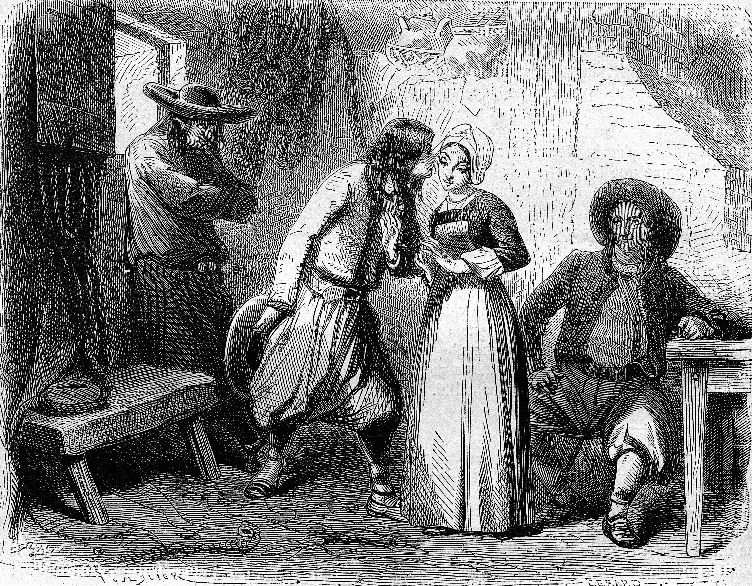
Romance blossoms in Douarnenez in The Count of Chanteleine
For Chanteleine, the Revolution has brought about an irrevocable change in his position, one which also gives him a new calling. Unlike Dakkar/Nemo, the count does not seek vengeance, although he has suffered almost as much. Chanteleine is constant and devout, with his motto, “For God and the King.” For him as for his fellow counter-revolutionaries, the divine and the potential justice of the monarchy are intertwined.
Faith, after nobility, is the second phase of Verne’s narrative. Nowhere did the opposition to the Civil Constitution coalesce in quite as widespread a way as in the Vendée. The Bretons had already long resented any lay interference into spiritual matters. (Goodwin, 333-334) Following increasing food shortages and the confiscation of local crops for the urban centers came a conscription order for 300,000 local men for the army. Counter-revolution was finally impelled by the government’s systematic dismantling of the church and its authority, subverting the religious order. (Piette, 90)
Before the Revolution, the clergy had enjoyed considerable power but used it wisely, according to the novel. No less than the aristocracy must embody heroic virtues to be justified within the story, so too the priesthood must serve their both their parish and God. This, too, follows formula, since in the adventure genre, the most prized men of God are combine the spiritual life with a ministry that active includes fighting injustice—not sacrificially “rendering unto Caesar.” Verne situates faith as not only central in this particular episode of French history, but as crucial to any people’s needs in time of upheaval and rebellion. Chanteleine observes, “I have seen them celebrating mass on a small, isolated hill, with a wooden cross, earthenware vessels, and vestments of coarse cloth. And then I have seen them rushing into the thick of battle, crucifix in hand, helping, comforting, absolving the wounded, even in the face of Republican cannon fire. I thought they were more to be envied there than they were before, in all the pomp of religious ceremonies.” (Chapter 10)
In order to practice, the new civil constitution forced priests to sign an oath of secular superiority over the spiritual realm. Those who refused faced prison, exile, or death. However, any priests who agreed to the oath were rejected by the church itself as well as the parishioners. In The Count of Chanteleine, one of the best of these was Yvenat, accepting a constitution signed by the king, but rejected by the peasants as a renegade and demon. Taking refuge on an island, the population expects him to starve to death, and only the Christian charity of Kernan rescues him. Chanteleine regrets that the Revolution’s impact has been to elicit such behavior, but he also says of Yvenet, “He didn’t realize what a sublime role a priest plays during these times of upheaval and terror.” (Chapter 10) Meanwhile, the Committee of Public Safety is too busy to avenge their priest.
With the churches shunned, newborns were not baptized, the dying did not receive the last rites, and marriages could not be performed. (Schama, 699) As a widower, Chanteleine is free to meet those spiritual needs by completing his youthful theological studies. He is ordained with the assistance of a priest in hiding, as those who still practiced the true faith could only do so effectively underground. (Piette, 91) This confirms Chanteleine’s own own circle of nobility, transforming from beneficent landowner to fighter to spiritual healer. He begins to secretly minister to the people, appearing for baptisms, last rites, and other rituals, and in the most vivid scene, in a church service inside a cavern of the Morgat Caves so that his daughter may be married.
In the dramatic highlight, the fishing flotilla enters an area accessible only at low tide, eager for spiritual succor and the celebration of the wedding. Potentially, it should be the place of romance and beauty, as occurs during the rescue in the Fingal Caves of Staffa in Verne’s later novel, Le Rayon vert (The Green Ray, 1882). Instead, in The Count of Chanteleine, love and natural beauty are inverted. A warship appears, Karval leading its boats filled with soldiers, firing indiscriminately into the congregation. The literal bloodbath in the Morgat Caves serves as another indication of the Republic’s treatment of its citizens, no less horrendous than the novel’s scenes of the guillotine.
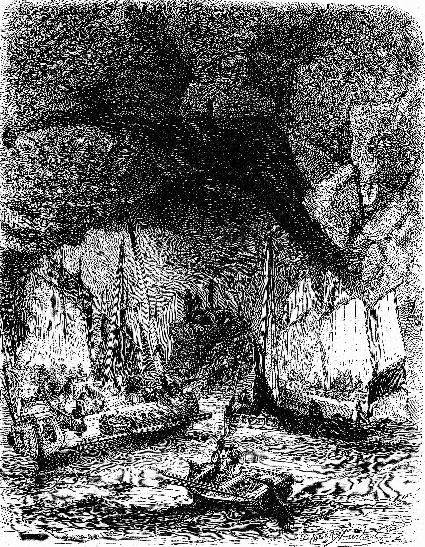 |
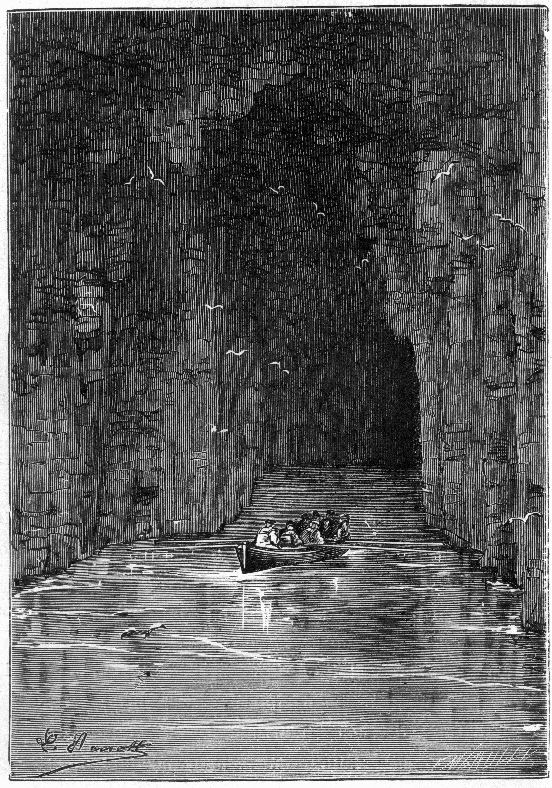 |
| |
|
Trailing Karval to try and save the count, Kernan captures his adversary at last. He proves to be the most cowardly of men, and when Karval offers a bribe, Kernan replies, “God would damn me, you wretch, if I didn’t kill you with my own hand.” (Chapter 15) However, he does permit him to make his confession, a practice of the Vendée partisans toward the Republicans. When Kernan and Karval locate a priest, it is none other than Yvenat, who is as terrified as Karval and gives him a cursory absolution. Fleeing, he hears a cry, as Karval is thrown from the rocks into the bay—a natural execution, so unlike the mechanical process of the guillotine.
The swashbuckler offers the comforting myth that any tyranny, no matter how formidable the arms and forces marshaled in its support, may be defeated by civilians. Despite inferior weapons, just as important is their sense of strategy and belief in justice, combined with the magnetism and skill of a hero's leadership. Plots frequently end with the principal villain meeting his death at the hands of the hero.
Despite the vengeance against Karval, the danger remains; Chanteleine has been sentenced as both an aristocrat and a priest. Before Kernan can attempt a rescue, however, there is a historical reverse, as adventure becomes interwined with the background of its story. Even as children have been enlisted to operate the guillotine to instruct indoctrinate youth in the Republic’s enemies, the public’s mood has shifted. At dawn on July 27, 1794, the 9th of Thermidor, the telegraph from Paris brings news of Robespierre’s death to the provinces. With the Terror having consumed its own perpetrators, there is a national sense of satiation and revulsion. Pity triumphs over anger, and divine providence allows the count and his family to escape imminent death.
So ends “this episode, taken from the darkest days of the Terror.” For Chanteleine himself, his own aristocratic position is abandoned in favor of trying to fill the void to assist the people in practicing the true faith. Eventually the count returns to his parish, preferring his humble priestly duties to the higher offices offered him. Answerable only to the church, not the state, he is no longer the count, but the curé of Chanteleine. History has allowed him to achieve his apotheosis, no less than did Dickens’s Sidney Carton through sacrifice.
Two books on this episode of history were in Verne’s library, Adolphe Thiers’s nine volume Histoire de la Révolution française (History of the French Revolution, 1834), and Louis de Carné’s novel, Un Drame sous la Terreur. Guiscriff, précédé d’une notice historique sur la Chouannerie (A Drama under Terror. Guiscriff, Preceded by a Historical Note on Chouannerie, 1835). The most prominent such work had been Honoré de Balzac’s 1829 breakthrough novel, Les Chouans (The Chouans). Following the style of Walter Scott, The Chouans was bound to have resemblances since both derived from the same tradition, but there were just as many divergences in terms of plot and characterization. [8]
Others followed the publication of The Count of Chanteleine, including Erckmann-Chatrian’s Histoire d’un Paysan (History of a Peasant, 1867) and Victor Hugo’s last novel Quatre-vingt treize (Ninety-Three, 1874). These were different from Verne’s approach, or that of Balzac, who depicted the trickery of the police as worse than that of the brigands. Hugo, for instance, sides with the Republic, and while his monarchists and revolutionaries are both sympathetic, the Bretons are regarded as savages.
Today, The Count of Chanteleine is more readily recognizable as typical of stories of the French Revolution, in which the new authorities, driven to the point of fanaticism by their zealotry, have become power-hungry and as cruel as their predecessors. The frenzy of the blood-hungry mob and the specter of the guillotine provide suspense, hinging on the danger to innocents. To rescue them requires courage, daring, and impersonation. The focus on individual aristocrats and their best traits make them sympathetic, and there are elements of the old order to be prized even while acknowledging the abuses by the upper class as an institution. Verne’s theatrical collaborator Adolphe d’Ennery composed the stage play, Les Deux Orphelines (The Two Orphans, 1874), telling of two persecuted heroines, sisters, one of them blind, during the Terror. Verne’s one-time patron, Dumas, extensively utilized the French Revolution as a setting, with characters sympathetic or antipathetic because of their actions, not because of their political preferences. Le Chevalier de Maison-Rouge was published in 1845, followed by the “Marie Antoinette” cycle that lasted for a dozen years with such novels as Joseph Balsamo, Mémoires d'un médecin, Le Collier de la Reine, Ange Pitou, and La Comtesse de Charny through Les Compagnons de Jehu. [9] While initially more fictive, actual history becomes steadily more important, with the fictional characters embodying certain social ideas, from the old aristocracy to the peasantry.
A distinctly Anglo-American tradition emerged, following the Dickens example in A Tale of Two Cities, with England seeming to offer safety from the whirlpool engulfing France. The same British youth who absorbed Verne in Boys’ Own also read G.A. Henty’s In the Reign of Terror, the Adventures of a Westminster Boy (1888). A particularly rich vein was established in 1903 in Baroness Emmuska Orczy’s series on The Scarlet Pimpernel. This formula of the guillotine menacing those who were guilty only by birth, and rescued by master of disguise Percy Blakeney and his intrepid followers, was offered initially in a play, and later a series of novels. The stories have proven durability as mass-entertainment in a succession of screen versions. As recently as 1997, the Pimpernel’s deeds formed the basis of a hit Broadway musical version that toured the United States and abroad, indicating the durability of this formula. Other plays have echoed Orczy, such as Le Chevalier au masque (The Masked Knight) by Paul Armont and Jean Manoussi in 1913. The only rival to Orczy’s popularity was Rafael Sabatini, especially in his novels Scaramouche (1921) and Scaramouche the King Maker (1931), which portray an illegitimate son of the aristocracy amidst the Revolution. A similarly complex view of the French Revolution also emerges in Sabatini’s The Trampling of the Lilies (1906), Venetian Masque (1934), The Lost King (1937), and Marquis of Carabas / Master-at-Arms (1940). Sabatini himself was a Verne enthusiast in his youth who devoured his stories (Knight and Darley, 5).
Hetzel not only disliked the apparent pro-royalist sentiment in The Count of Chanteleine, but also the importance attached to the clergy. He overlooked the anti-royal sentiment, such as the story saying that the Committee on Public Safety “saved France when it was caught up in all the horrors of the civil war and threatened by the coalition.” (Chapter 12) Hetzel’s literal reading ignored that the hero, amidst the brutal suppression of a counter-revolution, reveals the same political sympathy with struggles for liberation that were evident in a number of Verne’s colonial novels. Recently Hetzel’s view of The Count of Chanteleine was expressed by Verne biographer Herbert Lottman, who called the book “a bedtime story for counterrevolutionaries, written in romantic tremolo.” (Lottman, 107) Unfortunately, Hetzel and Lottman failed to fully grasp either the form or purpose of The Count of Chanteleine, utilizing the swashbuckler formula to spin a narrative around an important historical event. By contrast, more understanding was I.O. Evans, who noted in his preface to the Fitzroy edition of The Flight to France that The Count of Chanteleine “is upon traditional ‘Reign of Terror’ lines, with the usual traitor, the heroic counter-revolutionary movement and the virtuous aristocrats,” although he still regarded the story as unworthy. (Evans, 3)
Hetzel refused to publish The Count of Chanteleine in book form. The author had intended to include it in an anthology, Souvenirs d’enfance et de jeunesse (Memories of Childhood and Youth) that evolved into the posthumous Hier et demain (Yesterday and Tomorrow, 1910). However, even then his son Michel preferred to replace a historical novel with fiction having a more fantastic and scientific element—some of which he in fact authored using his father’s byline. As a result, The Count of Chanteleine did not appear in book form in French until 1971, published in Switzerland.
When Jules Verne tried another novel on the French Revolution, having been chastened by Hetzel, he avoided the pattern of Dickens and A Tale of Two Cities. Instead, Verne followed the lead of two other popular authors of the time who also published through Hetzel, Erckmann-Chatrian, and their series on the Napoleonic wars. For instance, their 1865 novel Waterloo (a sequel to the previous year’s Conscrit de 1813) was told in the first person by an ordinary soldier, who had survived the recent battles, hoping to return to peace. The life of a married tradesman is instead interrupted as he must reluctantly take up arms once again, during the Hundred Days.
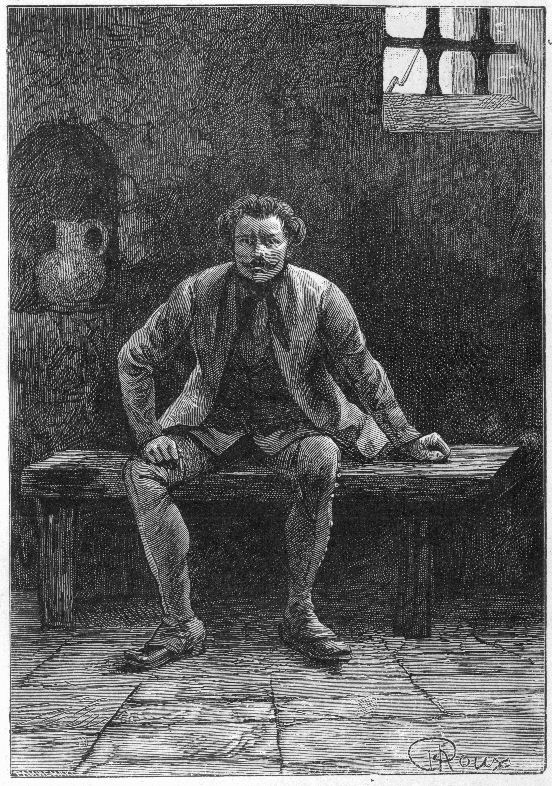
Natalis, the soldier, in The Road to France
A similar pattern was followed in The Road to France, although avoiding the disillusionment inherent in an account of the Emperor’s disastrous fall. Verne’s hero is Natalis Delpierre, the son of a tradesman, has been able to rise to the rank of officer, but remains at heart a simple soldier. He is visiting his sister in Germany when war breaks out in 1793 and the foreign coalition begins to march on France. Verne hoped the resulting patriotic tone would appeal to readers of the Magasin d’Éducation et de Récréation (Magazine of Education and Recreation), although the novel was eventually published in Le Temps instead. (Lottman, 262) Composed in anticipation of the celebration of the centennial of the Revolution, The Road to France is pre-eminently a “safe” book, one which could not offend anyone, but appeal to all—unlike its predecessor.

The frontispiece of The Road to France (1887)
The Road to France avoids the theme of oppression found in The Count of Chanteleine, and which had echoed in such other Verne adventure novels as The Archipelago on Fire, North Against South, Family Without a Name, Les Frères Kip (The Kip Brothers, 1902), and L’Invasion de la mer (The Invasion of the Sea, 1905). Rather, The Road to France becomes a celebration of nationalism, a motif distant from The Count of Chanteleine, and closer to the advocacy of the Quebec separatism found in Family Without a Name published two years later. Equally palatable in English speaking countries, The Road to France quickly appeared in Canada, England and the United States in 1888, with the title The Flight to France, suggesting a possible science fiction element to the casual book buyer.
While the American Revolution is not part of Chanteleine’s background, it is for Natalis, who fought alongside such heroes as Washington (described as a physical “giant”), Anthony Wayne, John Paul Jones, as well as Lafayette, and saw action at Yorktown. (Verne had planned to refer to some of these events in his unfinished 1847 novel, Jédédias Jamet ou L’Histoire d’une succession [Jédédias Jamet, or The Tale of an Inheritance].) France’s role in helping Americans gain their freedom provides a perspective on the subsequent Revolutionary events that would take place in their own country. Natalis remarks that he learned the lessons necessary to survive his trek from Germany to France during the tough winters on the American prairies, just as Kernan had tracked Karval like an Indian. (Chapter 15)
Natalis traveled to see his sister, in the service of the Kellers, a German family of French origin, Protestants who fled the Edict of Nantes in 1685. They retain the memory of their ancestral language and hope to return when there is greater religious tolerance. Germany had at one time offered the prospect of refuge, just as England had for Chanteleine’s family. However, the modern Germans are unfavorably portrayed, physically and morally, in a manner to be expected by a French author in the wake of the Franco-Prussian War. The Prussian government has the Keller commercial fortune tied up in an endless lawsuit inspired by Dicken’s bureaucratic “Jarndyce vs. Jarndyce” in Bleak House (1853), and their faithlessness is further demonstrated when the government dismisses all its debts to citizens of French ancestry with the declaration of war. A planned marriage between young Jean Keller and a French bride, Martha, renders their political position even more tenuous, especially when he is drafted to serve in the Prussian army under a rival for Martha’s hand, the aptly named Frantz von Grawert. Natalis must escort his sister and Jean’s mother, along with members of the employer’s family, including the fiancée and her father, back to safety behind the French lines.
Natalis and Jean Keller in The Road to France
Verne portrays a France in danger from the foreign machinations of the émigrés willing to use the armies of other countries to war against their homeland in order as a means to regain their power, a view far different from the domestic focus of The Count of Chanteleine. Grawert’s abuse compels Jean to desert, and he and Natalis are captured, and are facing a Prussian firing squad when French troops overrun their position. The timely intervention parallels the climax of The Count of Chanteleine, when the 9th of Thermidor preserves Chanteleine from the guillotine. The Road to France and The Count of Chanteleine both cast a decidedly proletarian figure at the center, since the latter is as much the story of Kernan. In The Road to France, however, there is not only no necessary opposition between aristocrat and peasant, but the divide between White and Blue is absent, and religion is only a minor element. Both books involve the return home—in The Road to France, to regain the safety of their homeland, but in The Count of Chanteleine to find the safety and peace of pre-Revolutionary France. For the Delpierres and Kellers, as for Chanteleine and his daughter, the life they knew is gone.
The tone of The Count of Chanteleine and The Road to France are contradictory, the latter concentrating upon the typical “Extraordinary Journeys” style, emphasizing the geographical journey through the border country. The Count of Chanteleine concentrated on history, with only incidental geography. The Count of Chanteleine, at 30,000 words, is also about half the length of The Road to France, and faster paced, resembling a traditional swashbuckler. The Road to France is more formal and distant in its use of the adventure formula as well as in its approach to tempo; where The Count of Chanteleine is vibrant and dashing, however, The Road to France plods. The Count of Chanteleine, while a less mature work, is much higher in entertainment value. The story demonstrates a young writer able to skillfully exploit formula, while The Road to France reveals one compelled to follow editorial guidance.
NOTES
- Cinq semaines en ballon (Five Weeks in a Balloon, 1863), Aventures de trois Russes et de trois Anglais dans l’Afrique australe (Adventures of Three Russians and Three Englishmen in Southern Africa, 1872). ^
- Un Hivernage dans les glaces (A Winter Amid the Ice, 1855), Voyages et aventures du capitaine Hatteras (Journeys and Adventures of Captain Hatteras, 1866), Le Pays des fourrures (The Fur Country, 1873), Le Sphinx des glaces (The Spinx of Ice, 1897). ^
- Les Forceurs de blocus (The Blockade Runners, 1865), Nord contre Sud (North Against South, 1887). ^
- L’Archipel en feu (The Archipelago on Fire, 1884). ^
- Famille-sans-nom (Family Without a Name, 1889). ^
- La Maison à vapeur (The Steam House, 1880), also referenced in an incidental but key passage in L’Île mystérieuse (The Mysterious Island, 1874). ^
- All translations are from the forthcoming first English-language edition, The Count of Chanteleine: A Tale of the French Revolution, Tr. Edward Baxter (Albany, GA: Bear Manor Fiction, 2011), published under the auspices of the North American Jules Verne Society. ^
- Balzac offered exciting episodes offering nobility, heroism, and the use of disguise on a journey in delineating the opposing historical forces of the peasants and the military. The Breton rebels are led by a marquis, and the Republican forces by a veteran who finds his own command superseded as a plot is hatched with a spy dispatched to seduce the marquis. They fall in love but there is no happy ending; just as much a contrast with Verne’s heartfelt romantic themes is Balzac’s depiction of the clergy as self-serving. The setting is later than Verne’s, in 1799. Balzac’s dissatisfaction with the initial generic form caused him to abridge The Chouans considerably to meet the more “literary” standards necessary to include it in his “La Comédie humaine” in 1834. George Saintsbury, “Preface,” in Balzac, 11-15; Bell, 58-68; Shaw, 82-97. ^
- These have often been translated in English under multiple titles, sometimes in several volumes; for instance, Joseph Balsamo, Mémoires d'un médecin is known as Joseph Balsamo, Cagliostro, Madame Dubarry, The Elixir of Life, and The Countess de Charny as Andrée de Taverney, or The Mesmerist's Victim. ^
WORKS CITED
Balzac, Honoré de. The Chouans. Tr. Ellen Marriage. New York: Macmillan, 1901.
Bell, David F. Real Time: Accelerating Narrative from Balzac to Zola. Champaign, IL: University of Illinois Press, 2003.
Compère, Daniel. “A la recherché des systèmes nouveaux.” Bulletin de la Société Jules Verne, No. 63 (1982): 250-258.
Courville, Luce. “Préface.” In Jules Verne. Le Comte de Chanteleine. Nantes: Editions joca seria, 1994. Pp. 7-9.
Evans, I.O., ed. The Fitzroy Edition of Jules Verne: The Flight to France. London: Arco, 1966.
Gaillou, Patrick and Michael Jones. The Bretons. Oxford: Blackwell, 1991.
Goodwin, A. “Counter-Revolution in Brittany.” Bulletin of the John Rylands Library Manchester, 39 (March 1957), 3226-355.
Knight, Jesse and Stephen Darley. The Last of the Great Swashbucklers—A Bio-Bibliography of Rafael Sabatini. New Castle, Delaware: Oak Knoll Press, 2010.
Lacassin, Francis. “Préface.” In Jules Verne. Histoires Inattendues. Paris: Union Generale d’Editions, 1982. Pp. 7-14.
Lottman, Herbert R. Jules Verne: An Exploratory Biography. New York: St. Martin’s, 1996.
Martin, Charles-Noel. “Préface.” In Jules Verne. L'Étonnante aventure de la mission Barsac, Oeuvres Romancées complètes, vol. 49. Lausanne, Éditions Rencontre, 1971. Pp. xiii-xv.
Piette, Gwenno. A Concise History of Brittany. Cardiff: University of Wales Press, 2008.
Sainlot, Claudine. “Les Tribulations du Comte de Chanteleine.” In Jules Verne. Le Comte de Chanteleine. Nantes: Editions joca seria, 1994. Pp. 121-127
Schama, Simon. Citizens. New York: Alfred A. Knopf, 1989.
Shaw, Harry E. Forms of Historical Fiction: Sir Walter Scott and His Successors. Ithaca, NY: Cornell University Press, 1983.
Taves, Brian. The Romance of Adventure: The Genre of Historical Adventure Movies. Jackson: University of Mississippi Press, 1993.
Wolcott, Norman, ed. Jules Verne’s The Blockade Runners—Dual Language Edition. St. Michael’s, MD: Choptank Press, 2007.
The author would like to thank fellow Vernians Volker Dehs, Jan Rychlik and especially Garmt de Vries-Uiterweerd for their insight in preparing the North American Jules Verne Society’s first English-language edition of The Count of Chanteleine which led to this essay. Further expertise on the adventure genre was provided by a close reading by David March of the Rafael Sabatini Society.
Engravings courtesy of Bernhard Krauth.


